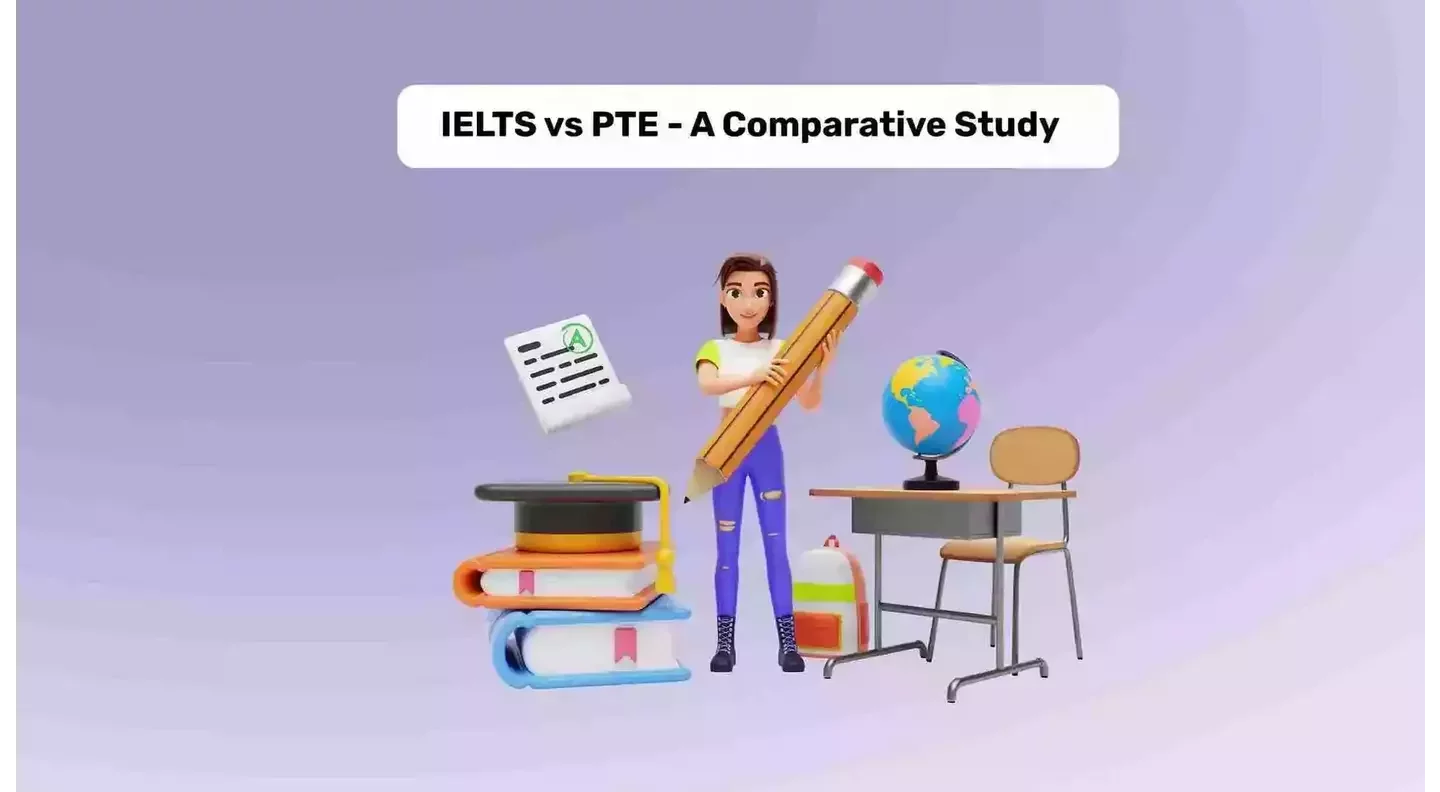Get instant loan offer suitable to your profile !


On this Page:
Explore a comprehensive comparison between IELTS and PTE exams, covering acceptance rates, test formats, scoring systems, fees, and more.
When it comes to studying abroad, one of the crucial steps in the application process is demonstrating proficiency in the English language. Universities worldwide often require applicants to submit test scores as proof of their English language skills. Among the various English language tests available, two prominent options that consistently rise to the top are the International English Language Testing System (IELTS) and the Pearson Test of English (PTE).
IELTS and PTE have emerged as the go-to choices for many students aspiring to pursue their education abroad. These tests evaluate the four essential language skills: listening, reading, writing, and speaking. With similarities in their exam structure and purpose, it's essential to understand the nuances that set them apart.

Both the IELTS and PTE evaluations are well organised to assess the overall English competency of a test taker. While IELTS has options for computer-based and pen-and-paper tests, PTE offers only computer-based tests. An overview of both tests will let you know the significant differences, which can be obtained from the following table:
| Features | IELTS | PTE |
|---|---|---|
|
Conducted by |
IDP Education Ltd. |
Pearson PLC group |
|
Test types |
IELTS Academic, IELTS General Training, IELTS Indicator |
PTE Academic |
|
Duration |
2 hours and 45 Minutes |
3 hours |
|
Break |
No breaks. Although, the speaking portion can be taken up to a week before or after the rest of the test. |
Optional 10 minutes |
|
Range of scores |
0 - 9 |
10 - 90 |
|
Mean of accepted score |
6.3 |
50 |
|
Result |
13 days after the test |
48 hours after the test |
|
Cost |
16,200 INR (198 USD) |
15,900 INR (194 USD) |
Must read: A comparison between IELTS vs TOEFL vs PTE vs Duolingo

As mentioned earlier, IELTS and PTE are almost similar in test format and syllabus. Both assess the test-takers reading, writing, listening, and speaking skills. IELTS has UK and US variants of English as its test medium, while PTE offers UK, US, and Australian variants of English.
See the tables below that give details on the test patterns of both the English language tests, and decide which test has an easier syllabus as per your abilities
|
Section |
Tasks - IELTS Academic |
Tasks - IELTS General Training |
|
Summarize or explain the given data, Write an essay |
Write a letter, Write an essay |
|
|
Reading 3 long texts |
Reading some everyday literature from newspapers, brochures, etc. |
|
|
A conversation between 4 people in an academic setting and a monologue on an academic subject |
A conversation between two people in an everyday context or a monologue set in a familiar setting |
|
|
General questions about the person and familiar topics, Speak about the topic written on the given card, More questions about abstract ideas and topics |
||
| Section | Tasks |
|---|---|
|
Speaking & Writing (54 - 67 minutes) |
Read aloud, repeat sentences, describe images, re-tell lecture, answer short question, summarize written text, essay |
|
Reading (30 minutes) |
Reading and writing blanks - drop-down, MCQ - multiple answers, reorder the paragraphs, reading blanks - drop-down, MCQ - single answer |
|
Listening (30 - 43 minutes) |
Summarize the spoken texts, MCQ - multiple answers, fill in the blanks, highlight correct summary, select missing words, MCQ - single answer, highlight incorrect words, write from dictation |
Must read: Which exam to take to study in US?

IELTS measures the scores as bands of 0 - 9 with 0.5 increments of bands. It applies to each section; the collective average is taken as the IELTS band score. Universities abroad usually demand a minimum of 6 - 6.5 in IELTS. *Standard Error Measurement (SEM) is 0.23 of an IELTS band.
PTE uses a Global Scale of English (GSE) of 10 - 90 marks. Each section has the same scale, and the collective average becomes the PTE score. A candidate must have a minimum of 55 - 60 out of 90 in the PTE to get admission to better universities abroad. The standard Error Measurement (SEM) is 2.3.
Equivalents of IELTS band scores and PTE GSE scores would look like:
| IELTS | PTE-A |
|---|---|
| 5 | 40.8 |
| 5.5 | 45.4 |
| 6 | 51.6 |
| 6.5 | 58.5 |
| 7 | 66.3 |
| 7.5 | 74.6 |
| 8 | 82.3 |
| 8.5 | 88.1 |
*(PTE-A stands for PTE Academic. Since there is no variant of PTE like IELTS General Training tests, both PTE and PTE-A signify PTE Academic)
Scores obtained in both tests are valid for two years. See the table below for the scoring criteria for each test:
|
Scoring Criteria |
IELTS Academic |
PTE |
|
Task achievement/task response, coherence and cohesion, lexical resource, grammatical range and accuracy, fluency and coherence, grammatical range and accuracy, pronunciation |
Content, oral fluency, pronunciation, development, structure and coherence, grammar, general linguistic range, vocabulary |
*Standard Error Measurement (SME) is the variation in a test-taker's score if taking it more than once.
Know how to convert IELTS scores to other exams

IELTS and PTE differ in their application fees and acceptance rates as given below:



PTE and IELTS scores are based on different scales and we will explain each in detail.
PTE scores are based on your communicative skills and overall performance. PTE scores are based on points, ranging from 10 to 90 with 10-point intervals. You will receive a detailed scorecard of points scored in each category.
IELTS scores are based on also based on your overall competence with the English language. It tests task response, coherence and cohesion, lexical resource grammatical range, and accuracy. Scoring is based on a band system, which ranges from 0 to 9, with a gap of 0.5 per section. Your overall band score is calculated as the average of the four sections. The acceptable range is from 6.0 to 6.5 for most universities.
An important difference between IELTS and PTE tests is that PTE is completely computer-marked, that computer will check and score you according to your answers, whereas in IELTS, the Reading and Listening sections are computer-marked, but the Writing and Speaking sections are marked by certified IELTS Examiners.

Let us understand what are the similarities between these two tests.
The primary purpose of both exams is to check your proficiency in English, in all forms, that is writing, reading, speaking, and listening.
IELTS and PTE tests are based on four essential components - Reading, Writing, Speaking, and Listening - to check your language skills in all aspects.
IELTS was earlier a pen-and-paper exam but is now available as a computer-based test, and PTE, a computer-based test from the beginning, provides candidates with the flexibility to respond in either the major UK or US English dialects. British and American variations of the language are also accepted.
Both IELTS and PTE use a detailed scoring system to assess your performance in all four sections, providing a complete evaluation of your language abilities.
IELTS and PTE are both popular and accepted by most universities, employers, and immigration authorities around the world which makes them essential for academic and professional purposes.

Let us understand the key differences between these two tests based on various factors.











Please refer to the table below for the conversion of scores from IELTS to PTE:
| IELTS | PTE |
|---|---|
|
5 |
35-42 |
|
5.5 |
43-50 |
|
6 |
51-58 |
|
6.5 |
59-64 |
|
7 |
65-72 |
|
7.5 |
59-64 |
|
8 |
79-82 |
|
8.5 |
83-85 |
|
9 |
86 and above |




Check Your Education Loan Eligibility

Ask from a community of 10K+ peers, alumni and experts
Trending Blogs
Similar Blogs

Network with a community of curious students, just like you
Join our community to make connections, find answers and future roommates.. Join our CommunityCountry-Wise Loans
Best Lenders for Education Loan

ICICI Bank

Axis Bank

Union Bank

Prodigy

Auxilo

Credila

IDFC

InCred

MPower

Avanse

SBI

BOB

Poonawalla

Saraswat